I am no historian or chronicler of facts, furthermore,
I hold a very definite conviction that there are certain subjects which
fiction writers should leave alone, foremost among which are politics and
religion. However, it seems to me not unethical to pirate an idea
occasionally from one or the other, provided that the subject be handled
in such a way as to impart a definite impression of fictionalizing. ~
E. R. Burroughs: Tarzan The Invincible
Pagination text: Tarzan And The Ant Men, Ballantine
Paperback Editions, 1963 et subs.
Prologue
1.
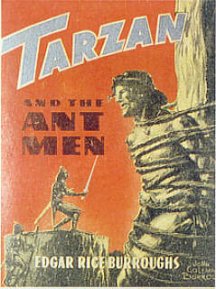 When I bought my childhood Tarzans in the early 1950s there
were only eight available from Grossett & Dunlap, Burroughs' long time
reprint publisher, plus two abridgements from Whitman Publishing of Racine,
Wisconsin. I had seven of the G&Ds and both Whitmans. I
never read the Whitmans -- Tarzan
And The City Of Gold and Tarzan
And The Forbidden City -- because they were abridgements.
Having checked my trusty Webster's Collegiate I knew what that meant, therefore
disdaining them. Besides they were cheap.
When I bought my childhood Tarzans in the early 1950s there
were only eight available from Grossett & Dunlap, Burroughs' long time
reprint publisher, plus two abridgements from Whitman Publishing of Racine,
Wisconsin. I had seven of the G&Ds and both Whitmans. I
never read the Whitmans -- Tarzan
And The City Of Gold and Tarzan
And The Forbidden City -- because they were abridgements.
Having checked my trusty Webster's Collegiate I knew what that meant, therefore
disdaining them. Besides they were cheap.
The publishing history of Burroughs
is a very strange one. It was almost as though his publishers were
trying to sabotage his success. Because of Burroughs arrangement
with his publisher McClurg's they retained control of the first twelve
Tarzan titles until about 1960 which they leased to G&D sharing the
royalties with Burroughs 50-50. The remaining titles, which were
never available in my youth, except the two abridgements, belonged to ERB,
Inc.
At the time I bought my titles
only eight of the twelve belonging to McClurg's were in release.
Oddly enough the original title, Tarzan
Of The Apes, was not available. Why G&D didn't publish
the original is unknown to me but it very probably had not been available
from sometime in the twenties until the sixties. It may not have
been available for less than ten years after its publication in 1914.
Strikes me as very strange that the defining volume was purposely withheld.
At any rate Burroughs, McClurg's and G&D were at odds the whole term
of their relationship.
Although Burroughs is credited
with selling tens of millions of copies during his lifetime it is difficult
to see how. The Tarzan novels were far and away his best sellers
with the Mars series a distant second. Of the secondary titles published
by McClurg's in the twenties most were available for a very short time,
the plates being sold to ERB as worthless shortly after publication.
It was only in the sixties that
the entire corpus became available and actually sold well. At that
time two additional Tarzan titles were discovered and published bringing
the series total to twenty-four. As Burroughs declined to publish
them in his lifetime he can't be held responsible for their draftlike quality.
Of the seven titles I had the
ones that made the deepest impression on me were Tarzan
The Terrible, Tarzan
And The Jewels Of Opar and Tarzan
And The Ant Men.
It is now difficult for me to
capture the wonder and awe with which I read Ant Men. I can
remember my hands shaking, my mouth slack as I turned from page to page.
I remember nothing of the Alali or the story of Esteban Miranda although
the character made a deep impression on my mind. I just couldn't
tell you in what stories he appeared.
The miraculous story of the Ant
Men, -- the true pygmies as the novel declared -- captured my attention.
I can't now recall what allegory or symbolism I attached to the story as
I knew that like a poet Burroughs was talking about something else. I found
the allegory intensely exciting. This more than anything convinced me of
his genius.
The core of the value Tarzan
had to impart lay with this book. While I remembered the hive-like
activity of the Minunian cities, what impressed me most were the scenes
in the underground quarries. I probably related on the unconscious
level to the plight of Talaskar on the Anima level and Tarzan on the level
of the Animus. I probably interpreted their plights as representing
mine.
I didn't actually recall any
of the story of the caverns. So What? The fifteen or twenty
pages or so impressed themselves indelibly on my memory as a dream.
Those pages, some scenes from Tarzan The Terrible and the Opar story
from Jewels Of Opar form the basis of my reverence for Tarzan and
Burroughs.
2.
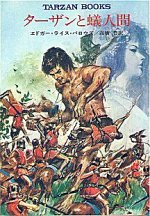 Ant Men, the tenth Tarzan novel, is about ten years after the first
so with an average of one a year through some very tumultuous times, both
personal and historical, ERB was definitely keeping one part of his mind
focused on his writing which continued to be prolific.
Ant Men, the tenth Tarzan novel, is about ten years after the first
so with an average of one a year through some very tumultuous times, both
personal and historical, ERB was definitely keeping one part of his mind
focused on his writing which continued to be prolific.
One is astonished that he could
turn out complex and coherent stories while under such stresses.
The range of subject matter is also astonishing, especially since his 1919
move to California when his troubles really began. He published science
fiction, realistic and Western stories as well as at least three of the
Tarzan series. In addition he appears to have been reading voluminously.
Burroughs really had an astonishing mind to compartmentalize all those
concerns.
The idea of the miniature men
was suggested to him by his editor at Munsey, Bob Davis, according to biographer
Porges. One can't take a writer's statements at face value but Burroughs
said at this time that he was about written out on Tarzan, having said
everything about him there was to say.
There may be some truth to the
statement since there is a hiatus of Tarzan stories from Ant Men
of 1923 to Tarzan, Lord
Of The Jungle in 1927. Lord Of The Jungle is also
the weakest of the Tarzan's to that date. Then there was a burst
of brilliant activity from 1928's Lost Empire though the mid-thirties
when ERB was under political pressure from the Left.
If Davis did suggest the miniature
men theme then Burroughs handled it in a most brilliant manner. While
ERB may have read Swift's Lilliputian story there is little evidence of
a direct influence save the brief theme of a giant among tiny people.
In Tarzan's wavering physical stature it is interesting to note that he
is four times the Minunian stature of eighteen inches making him an even
six feet once again. His double running around the jungle is presumable
still at 6' 3" making him noticeably taller than the giant man-god cum
beast. Wow! What a guy, huh?
Although ERB did use Davis' suggestion
for Ant Men he has actually combined three stories within the frame of
the airplane crash.
I. Tarzan And The Alali
II. Tarzan And Esteban Miranda
III. Tarzan And The Ant Men
In my analysis I will treat each
story separately in the above order.
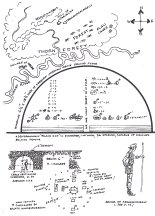
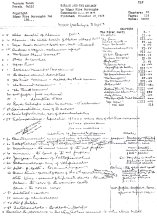
Two Ant Men work sheets from ERB's writing
journal

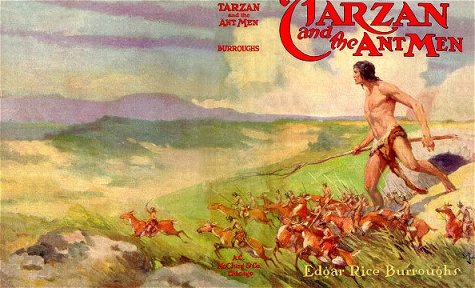
 When I bought my childhood Tarzans in the early 1950s there
were only eight available from Grossett & Dunlap, Burroughs' long time
reprint publisher, plus two abridgements from Whitman Publishing of Racine,
Wisconsin. I had seven of the G&Ds and both Whitmans. I
never read the Whitmans -- Tarzan
And The City Of Gold and Tarzan
And The Forbidden City -- because they were abridgements.
Having checked my trusty Webster's Collegiate I knew what that meant, therefore
disdaining them. Besides they were cheap.
When I bought my childhood Tarzans in the early 1950s there
were only eight available from Grossett & Dunlap, Burroughs' long time
reprint publisher, plus two abridgements from Whitman Publishing of Racine,
Wisconsin. I had seven of the G&Ds and both Whitmans. I
never read the Whitmans -- Tarzan
And The City Of Gold and Tarzan
And The Forbidden City -- because they were abridgements.
Having checked my trusty Webster's Collegiate I knew what that meant, therefore
disdaining them. Besides they were cheap.
 Ant Men, the tenth Tarzan novel, is about ten years after the first
so with an average of one a year through some very tumultuous times, both
personal and historical, ERB was definitely keeping one part of his mind
focused on his writing which continued to be prolific.
Ant Men, the tenth Tarzan novel, is about ten years after the first
so with an average of one a year through some very tumultuous times, both
personal and historical, ERB was definitely keeping one part of his mind
focused on his writing which continued to be prolific.


